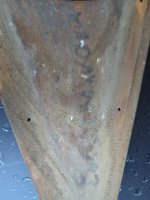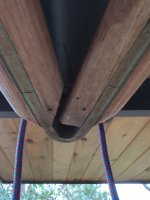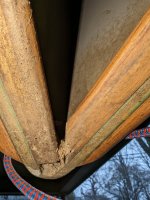Update: I picked up the boat on my way home from Maryland on Sunday. We made it home safe in some high winds and highway speeds. Aside from the cold cracks (which I terminated with drilled holes before leaving the sellers driveway) the boat is in pretty good shape. The hull wasn’t abused and the wood just needs some sanding and oiling.


I have a small basement space to work in, so after moving my other canoe to my dad’s garage and building some cradles I got this one inside and got to work removing seats, grab handles, gunnels, and yoke.


I found 9 separate cold cracks, the longest being around 3 inches. All located near bow and stern. I think the previous owner may have been lifting and carrying the canoe from loops of rope he had tied through the holes at bow and stern, I wonder if this could have contributed to the cold cracking? He also stored the boat under a carport outside year round which is the obvious culprit.

I followed advice from all of you as well as dcloots/maintripper’s YouTube videos for the repairs. I ordered some g-flex and went to the store and got some new toys.

I started by using a jig saw to open the cracks.

Then a dremel tool with a #94 cutting head to bevel them on the inside and outside.

Then I lightly sanded my bevels with 80 grit sandpaper and wiped down the area with acetone. I applied heat for a minute or so with a heat gun to attempt to “oxidize the plastic surface and improve adhesion” per g-flex instructions. They note that no obvious change occurs when you do this, but that it helps. I then taped the exterior of the beveled cracks with packing tape so I could fill with epoxy from the inside. I did this to minimize/eliminate any cleanup on the exterior of the hull.


After the beveled space was filled with epoxy, I added a piece of packing tape to the interior and then clamped with a spring clamp.
I did notice a few bubbles behind the tape and did my best to poke holes and squeeze them out, but I wasn’t able to get all of them. I wonder if there is something I should have done differently to prevent this?
The epoxy is currently curing. I plan to continue posting updates. So far I am happy with the process. Thanks for all the advice everyone.














